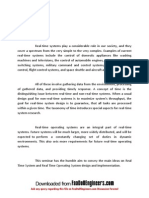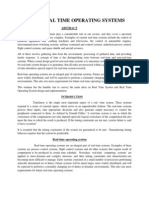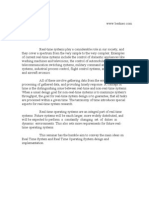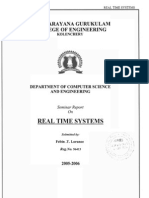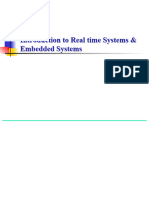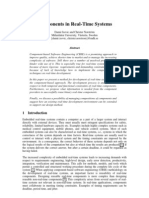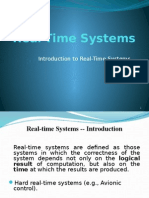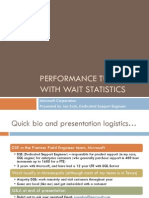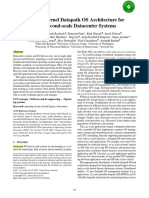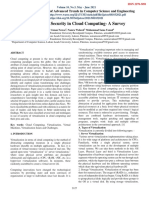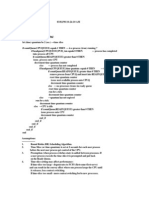RtEmbSysSurvey Stankovic
RtEmbSysSurvey Stankovic
Uploaded by
ashutoshupadhyay849Copyright:
Available Formats
RtEmbSysSurvey Stankovic
RtEmbSysSurvey Stankovic
Uploaded by
ashutoshupadhyay849Original Description:
Copyright
Available Formats
Share this document
Did you find this document useful?
Is this content inappropriate?
Copyright:
Available Formats
RtEmbSysSurvey Stankovic
RtEmbSysSurvey Stankovic
Uploaded by
ashutoshupadhyay849Copyright:
Available Formats
Real-Time and Embedded Systems
JOHN A. STANKOVIC
University of Massachusetts, Amherst ^stankovic@cs.umass.edu&
Real-time systems are those systems in tures based on single-board computers
which the correctness of the system de- (many are still 68000-based, but RISC
pends not only on the logical results of processors are being used more and
computation but also on the time at more) and buses such as the VME bus.
which the results are produced [Stan- Many people are involved with the pro-
kovic 1988]. They span a broad spec- gramming and debugging of embedded
trum of complexity from very simple systems, largely using the C program-
microcontrollers in embedded systems ming language and cross development
(a microprocessor controlling an auto- and debugging platforms. Embedded
mobile engine) to highly sophisticated, systems may or may not have real-time
complex, and distributed systems (air constraints.
traffic control for the continental United Hard real-time systems are those in
States). Other real-time systems in- which missing an important deadline
clude command and control systems, can cause severe consequences, even
process control systems, and multime- death. In this area, many fundamental
dia and high-speed communication sys- results have been developed. For exam-
tems. Some real-time systems are be- ple, in real-time scheduling, rate mono-
ginning to add expert systems and other tonic analysis has enabled careful eval-
AI technology, creating additional re- uation of many practical systems; the
quirements and complexities. At least concept and analysis of competitive al-
three major trends in the real-time and gorithms has provided important sched-
embedded systems field have had a ma- uling bounds and limits; and on-line
jor impact on its technology: the in- planning has added flexible and dy-
creased growth and sophistication of namic capabilities to real-time systems.
embedded systems, the development of Operating systems research has pro-
more scientific and technological results duced predictable primitives, time-con-
for hard real-time systems, and the ad- strained synchronization techniques,
vent of distributed multimedia. and reservation and admission-control
Most embedded systems consist of a paradigms. Many other results exist in
small microcontroller and limited soft- real-time architecture, fault tolerance,
ware situated within some product such communication protocols, specification
as a microwave oven or automobile. and design tools, formal verification, da-
However, with the increasing sophisti- tabases and object-oriented systems.
cation of such systems, powerful micro- Emphasis on all these areas is expected
controllers and digital signal processing to increase in the foreseeable future.
(DSP) chips are commonly used, as are Many hard real-time systems are em-
off-the-shelf real-time operating sys- bedded systems.
tems and design and debugging tools. Distributed multimedia have pro-
Many people working with embedded duced a new set of soft real-time re-
systems deal on a daily basis with sen- quirements. Real-time principles lie at
sors and data acquisition technology the heart of distributed multimedia, but
and systems; others construct architec- without the concomitant high reliability
Copyright © 1996, CRC Press.
ACM Computing Surveys, Vol. 28, No. 1, March 1996
206 • John A. Stankovic
requirements found in safety-critical, uations, however, some leeway does ex-
hard real-time systems. ist. For example, even on an automated
factory floor, if it is estimated that the
Underlying Principles. Typically, a correct command to a robot cannot be
real-time system consists of a control- generated on time, it may be appropri-
ling and a controlled system. For exam- ate to command the robot to stop (pro-
ple, in an automated factory, the con- vided no other moving objects will col-
trolled system is the factory floor with lide with it and cause a different type of
its robots, assembling stations, and the disaster) or to slow down (thereby dy-
assembled parts, while the controlling namically generating more time to pro-
system is the computer and human in- duce a correct command).
terfaces that manage and coordinate the We now discuss underlying principles
activities on the factory floor. Thus, the in several representative areas of real-
controlled system can be viewed as the time computing, including real-time
environment with which the computer scheduling, real-time kernels, and dis-
interacts. tributed multimedia.
The controlling system interacts with
its environment using information Real-time scheduling. Real-time sched-
about the environment available from uling is the process of creating start and
various sensors. It is imperative that finish times for sets of tasks such that
the state of the environment as per- all timing, precedence, and resource
ceived by the controlling system be con- constraints are met. Real-time schedul-
sistent with the actual state of the envi- ing results in recent years have been
ronment. Hence, periodic monitoring of extensive. Theoretical results have
the environment as well as timely pro- identified worst-case bounds for dy-
cessing of the sensed information is nec- namic on-line algorithms, and complex-
essary. ity results have been produced for
Timing correctness requirements in a various types of assumed task-set char-
real-time system arise because of the acteristics.
physical impact of the controlling sys-
tem’s activities upon its environment More applied scheduling results have
via actuators. The most common timing also been produced. For example, an
constraints for tasks are periodic, aperi- extensive set of improvements has been
odic, and sporadic. A periodic task is made to the rate monotonic algorithm,
one that is activated every T units. The which assigns the highest priority to the
deadline for each activated instance most frequent periodic task. Often a
may be less than, equal to, or greater system has both periodic and sporadic
than the period T. An aperiodic task is tasks. To handle this situation, the spo-
activated at unpredictable times. A spo- radic server algorithm was invented.
radic task is an aperiodic task with the This algorithm guarantees that the
additional constraint that there is a deadlines of all periodic tasks will be
minimum interarrival time between met and provides excellent response
task activations. time for the sporadic tasks. Techniques
What happens when timing con- were also created to handle the problem
straints are not met? The answer de- of priority inversion, a situation where
pends, for the most part, on the type of a low-priority task holds a resource re-
application. A real-time system that quired by a high-priority task. A set of
controls a nuclear power plant or a mis- algorithms that perform dynamic on-
sile cannot afford to miss timing con- line planning were also produced. These
straints for critical tasks. Resources algorithms have many nice properties,
needed for critical tasks in such systems including quality of service guarantees,
must be preallocated so that the tasks early warning that a deadline will be
can execute without delay. In many sit- missed, and admission control. We have
ACM Computing Surveys, Vol. 28, No. 1, March 1996
Real-Time and Embedded Systems • 207
also seen the development of scheduling over the network. This is known as end-
results for imprecise computation—a to-end scheduling.
situation where tasks obtain a greater The Mars project [Kopetz 1989], the
value the longer they execute up to Spring project [Stankovic 1991], and a
some maximum value. project at the University of Michigan
[Shin 1991] are all attempting to solve
Real-time kernels. Operating systems distributed end-to-end scheduling. The
must provide basic support for predict- Mars project uses an a priori analysis
ably satisfying real-time constraints, for and then statically schedules and re-
fault tolerance and distribution, and for serves resources so that distributed exe-
integrating time-constrained resource al- cution can be guaranteed to make its
locations and scheduling across a spec- deadline. The Spring approach supports
trum of resource types, including sensor dynamic requests for real-time virtual
processing, communications, CPU, mem- circuits (guaranteed delivery time) and
ory, and other forms of I/O. At least three real-time datagrams (best-effort deliv-
issues need to be addressed: ery) integrated with CPU scheduling so
—The time dimension must be elevated as to guarantee application-level end-to-
to a central principle of the system, end timing requirements. Spring uses a
not simply left as an afterthought. distributed reflective memory based on
a fiber optic ring to achieve the lower-
—The basic paradigms found in today’s level predictable communication proper-
general-purpose distributed operating ties. The Michigan work also supports
systems must change. Currently, they dynamic real-time virtual circuits and
are based on the notion that applica- datagrams, but is based on a general
tion tasks request resources as if they multi-hop communication subnet.
were random processes; operating Regarding the portability of applica-
systems are designed to expect ran- tions, many real-time UNIX operating
dom inputs and to display good aver- systems are appearing [Furht 1991],
age-case behavior. The new paradigm and a standard for real-time operating
must be based on the delicate balance systems, RT POSIX, is being developed
of flexibility and predictability: the [Gallmeister 1995]. While such stan-
system must remain flexible enough dards facilitate porting the code, how to
to allow a highly dynamic and adap- assess the timing properties of the
tive environment, but at the same ported application is still an open issue.
time be able to predict and possibly
avoid resource conflicts so that timing Distributed multimedia. Many real-
constraints can be met. time control applications, such as agile
—A highly integrated and time-con- manufacturing and process control, op-
strained resource allocation approach erate in highly nondeterministic envi-
is necessary to address timing con- ronments under timing constraints of
straints, predictability, adaptability, many types. Significant improvements
correctness, safety, and fault toler- can be made by embedding continuous
ance. and multimedia support in these appli-
cations. For example, in agile manufac-
Real-time kernels are also being ex- turing, remote factories, each consisting
tended to operate in highly cooperative of many automated workcells, must co-
multiprocessor and distributed system ordinate to handle new strategies for
environments. In such systems, sets of incoming product orders, to design new
communicating tasks (possibly located products, to schedule just-in-time deliv-
across a network) must be scheduled to eries of manufactured components, to
complete before a deadline, accounting monitor the plant operations, and to
for all system overheads, such as mes- solve difficult manufacturing floor prob-
sage copying and message transmission lems collaboratively.
ACM Computing Surveys, Vol. 28, No. 1, March 1996
208 • John A. Stankovic
To implement solutions cost-effec- facturing and process control into the
tively and give multimedia applications next generation.
direct access to plant operational data,
it is envisioned that the same comput- REFERENCES
ers would control the time-constrained FURHT, B., GROSTICK, D., GLUCH, D., RABBAT, G,
operations in and across the workcells PARKER, J., AND MCROBERTS, M. 1991. Real-
and support multimedia [Guha 1995]. Time Unix Systems, Design and Application
The backbone network would likely be Guide. Kluwer Academic, Boston, MA.
ATM. Distributed multimedia over ATM GALLMEISTER, B. 1995. POSIX.4: Programming
for the Real World. O’Reilly and Associates,
networks has enormous potential to Sebastopol, CA.
provide these applications with telecon- GUHA, A., PAVAN, A., LIU, J., RASTOGI, A., AND
ferencing for real-time coordination and STEEVES, T. 1995. Supporting real-time and
collaborative design, as well as visual multimedia applications on the Mercury test-
access via cameras to remote and local bed. IEEE J. Select. Areas Commun. 13, 4,
749 –763.
plant operations. These applications
KOPETZ, H., DAMM, A., KOZA, C., AND MULOZZANI,
would also benefit from a distributed D. 1989. Distributed fault tolerant real-time
real-time database that contains sensor systems: The Mars approach. IEEE Micro 9, 1,
information and the values of control 25– 40.
variables, both constrained by temporal SHIN, K. 1991. HARTS: A distributed real-time
validity intervals, plant operational architecture. IEEE Computer 24, 5, 25–35.
data, information on availability of raw STANKOVIC, J. 1988. Misconceptions about real-
materials, inventory of products, cus- time computing: A serious problem for next
generation systems. IEEE Computer 21, 10,
tomer orders, and so on. The confluence 10 –19.
of real-time databases, multimedia, and STANKOVIC, J. AND RAMAMRITHAM, K. 1991. The
real-time control has great potential for Spring kernel: A new paradigm for real-time
moving application areas such as manu- systems. IEEE Software 8, 3, 62–72.
ACM Computing Surveys, Vol. 28, No. 1, March 1996
You might also like
- RTOSDocument20 pagesRTOSKarteek Irukulla50% (2)
- Real-Time Operating SystemsDocument39 pagesReal-Time Operating SystemsAman JainNo ratings yet
- RTS Ptu Sample Paper Lords MBDDocument48 pagesRTS Ptu Sample Paper Lords MBDKaveesh NykNo ratings yet
- Rtos-Real-time Operating Systems: EchaloneDocument39 pagesRtos-Real-time Operating Systems: EchaloneTobe EziashiNo ratings yet
- New Trends in Real Time Operating Systems: Ms. Shraddha S. Nakate, Dr. Bandu. B. MeshramDocument10 pagesNew Trends in Real Time Operating Systems: Ms. Shraddha S. Nakate, Dr. Bandu. B. MeshramconnectvprakashNo ratings yet
- RTOS - Real Time Operating SystemsDocument36 pagesRTOS - Real Time Operating Systemsrs0728No ratings yet
- Real Time Operating SystemsDocument12 pagesReal Time Operating SystemsSubrahmanyam PadalaNo ratings yet
- Rtos SeminarDocument3 pagesRtos SeminarKiran Kumar GNo ratings yet
- Real Time SystemsDocument26 pagesReal Time Systemssreehari143No ratings yet
- Software Metrics For Real Time ApplicationDocument7 pagesSoftware Metrics For Real Time ApplicationmstradersgojraNo ratings yet
- How Does Control Timing Affect Performance Analysis and Simulation of Timing Using Jitterbug and TrueTimeDocument15 pagesHow Does Control Timing Affect Performance Analysis and Simulation of Timing Using Jitterbug and TrueTimefreesoul8300No ratings yet
- INTRODUCTION-WPS OfficeDocument14 pagesINTRODUCTION-WPS Officesimon ochekaNo ratings yet
- Inroduction To Real Time SystemsDocument27 pagesInroduction To Real Time SystemsRajini GuttiNo ratings yet
- Real Time Systems Notes FinalDocument37 pagesReal Time Systems Notes FinalAdarshNo ratings yet
- Real Time Systems Ques & AnsDocument8 pagesReal Time Systems Ques & AnsAdarshNo ratings yet
- Real Time SystemsDocument27 pagesReal Time SystemsSimmi JoshiNo ratings yet
- Unit III: 3.1 Introduction To Real Time SystemsDocument36 pagesUnit III: 3.1 Introduction To Real Time SystemsRoseNo ratings yet
- CH 1Document60 pagesCH 1gcrossnNo ratings yet
- Rtas 08Document10 pagesRtas 08shridharbvbNo ratings yet
- RTOS VxWorksDocument8 pagesRTOS VxWorksAshraful HimelNo ratings yet
- SAD Unit 4 Real Time Systems1Document20 pagesSAD Unit 4 Real Time Systems1onesnoneNo ratings yet
- Real-Time Systems Interview Questions and Answers: Q1: What Do You Mean by A Real-Time System?Document4 pagesReal-Time Systems Interview Questions and Answers: Q1: What Do You Mean by A Real-Time System?ರಾಕೇಶ್ ಕೆ ವಿಶ್ವಕರ್ಮNo ratings yet
- Dcap608 Real Time SystemsDocument148 pagesDcap608 Real Time Systemstauseef qidwaiNo ratings yet
- Real Time SystemDocument6 pagesReal Time SystemShekhar KumarNo ratings yet
- Scheduling PDFDocument49 pagesScheduling PDFwoodpecker029No ratings yet
- CSC 316 Week 1Document4 pagesCSC 316 Week 1gfox012345No ratings yet
- Habib Ur Rehman (049) & Shahab MughalDocument7 pagesHabib Ur Rehman (049) & Shahab MughalHabib ur rehmanNo ratings yet
- The Concept of Real-Time Systems: Mojtaba Ahmed Noori KhudairDocument5 pagesThe Concept of Real-Time Systems: Mojtaba Ahmed Noori Khudairm2 kvNo ratings yet
- Operating System: Assignment # 2Document6 pagesOperating System: Assignment # 2Habib ur rehmanNo ratings yet
- Operating System: Assignment # 2Document6 pagesOperating System: Assignment # 2Habib ur rehmanNo ratings yet
- WINSEM2023-24 BCSE305L TH VL2023240501060 2024-04-08 Reference-Material-IDocument12 pagesWINSEM2023-24 BCSE305L TH VL2023240501060 2024-04-08 Reference-Material-IavogadroangsterNo ratings yet
- Realtime Operating Systems For Embedded ComputingDocument5 pagesRealtime Operating Systems For Embedded ComputingRishabh DesaiNo ratings yet
- Review PaperDocument9 pagesReview Paperhowida nafaaNo ratings yet
- A Comprehensive Approach in Performance Evaluation For Modern Real-Time Operating SystemsDocument8 pagesA Comprehensive Approach in Performance Evaluation For Modern Real-Time Operating Systemsjustinleelee0273No ratings yet
- Soft RTOSDocument25 pagesSoft RTOSPrasanna VenkatesanNo ratings yet
- Components in Real-Time SystemsDocument12 pagesComponents in Real-Time SystemsSupervis0rNo ratings yet
- Lec 01Document18 pagesLec 01Moneeb AsifNo ratings yet
- What Is Real Time and Why Do I Need It?: by Steve FurrDocument4 pagesWhat Is Real Time and Why Do I Need It?: by Steve FurrPhilbert Bobbyne FerdinandNo ratings yet
- A Hardware-Scheduler For Fault Detection in RTOS-Based Embedded SystemsDocument7 pagesA Hardware-Scheduler For Fault Detection in RTOS-Based Embedded SystemsEvaldo Carlos F Pereira Jr.No ratings yet
- Erts Unit IIIDocument30 pagesErts Unit IIIsenthilkumarNo ratings yet
- Realtime Operating System (15EC743 / 10EC762)Document124 pagesRealtime Operating System (15EC743 / 10EC762)well wisherNo ratings yet
- os term paperDocument18 pagesos term papernrpawar2149No ratings yet
- Survey of Real Time Scheduling Algorithms: Swati Pandit, Rajashree ShedgeDocument8 pagesSurvey of Real Time Scheduling Algorithms: Swati Pandit, Rajashree ShedgeTesalonikaNo ratings yet
- Quality of Service SchedulingDocument22 pagesQuality of Service Schedulingikmalmughni.21002No ratings yet
- RtosDocument5 pagesRtosfyodNo ratings yet
- CSC 316 Week 3Document6 pagesCSC 316 Week 3gfox012345No ratings yet
- Chapter11.Real Time SystemsDocument29 pagesChapter11.Real Time SystemsAllan WachiraNo ratings yet
- Partitioned Real-Time Scheduling For Preventing Information Leakage 221116 131642Document13 pagesPartitioned Real-Time Scheduling For Preventing Information Leakage 221116 131642NIPUN PETKARNo ratings yet
- Unit-3 - Advanced Operating Systems-23pcsce24-3Document15 pagesUnit-3 - Advanced Operating Systems-23pcsce24-3Friends of GADGETSNo ratings yet
- Real Time Operating SystemsDocument35 pagesReal Time Operating SystemsNeerajBoora100% (1)
- Design Automation of Cyber-Physical SystemsFrom EverandDesign Automation of Cyber-Physical SystemsMohammad Abdullah Al FaruqueNo ratings yet
- Model-Driven Online Capacity Management for Component-Based Software SystemsFrom EverandModel-Driven Online Capacity Management for Component-Based Software SystemsNo ratings yet
- Embedded Systems Programming with C++: Real-World TechniquesFrom EverandEmbedded Systems Programming with C++: Real-World TechniquesNo ratings yet
- Real-Time Analytics: Techniques to Analyze and Visualize Streaming DataFrom EverandReal-Time Analytics: Techniques to Analyze and Visualize Streaming DataNo ratings yet
- Rust Concurrency CookbookDocument212 pagesRust Concurrency CookbookvenkatnethaNo ratings yet
- Linux Vs WindowsDocument24 pagesLinux Vs WindowsAngel MendezNo ratings yet
- Joe Sack Performance Troubleshooting With Wait StatsDocument56 pagesJoe Sack Performance Troubleshooting With Wait StatsAamöd ThakürNo ratings yet
- FreeRTOS MelotDocument39 pagesFreeRTOS MelotKonstantin BakunovNo ratings yet
- Cse323 08Document3 pagesCse323 08Prince DebNo ratings yet
- Red Hat Enterprise Linux-5-Tuning and Optimizing Red Hat Enterprise Linux For Oracle 9i and 10g Databases-En-USDocument136 pagesRed Hat Enterprise Linux-5-Tuning and Optimizing Red Hat Enterprise Linux For Oracle 9i and 10g Databases-En-USPoeta GyeNo ratings yet
- Operating System Exercises - Chapter 5-ExrDocument2 pagesOperating System Exercises - Chapter 5-ExrevilanubhavNo ratings yet
- Milan Milenkovic Operating Systems Concepts and Design DF56EDocument12 pagesMilan Milenkovic Operating Systems Concepts and Design DF56EGianniNicheliNo ratings yet
- Systems Reference Library: OS Release 21Document108 pagesSystems Reference Library: OS Release 21Ioana IoanaNo ratings yet
- Operating System AnswersDocument81 pagesOperating System Answersdevika kachhawahaNo ratings yet
- Missing Data If Any May Be Assumed Suitably. Answer All The QuestionsDocument2 pagesMissing Data If Any May Be Assumed Suitably. Answer All The QuestionsDeepak JhaNo ratings yet
- Embedded Systems Design - Lecture Notes, Study Material and Important Questions, AnswersDocument29 pagesEmbedded Systems Design - Lecture Notes, Study Material and Important Questions, AnswersM.V. TVNo ratings yet
- Deadlock AvoidanceDocument19 pagesDeadlock AvoidanceJayabalanNNo ratings yet
- Syllabus Bca Program Jnvu Jai Narain Vyas University JodhpurDocument24 pagesSyllabus Bca Program Jnvu Jai Narain Vyas University JodhpurVishwa RathoreNo ratings yet
- 13a SchedulingDocument33 pages13a SchedulingmyjunkgarbagejunkNo ratings yet
- AutosysDocument34 pagesAutosysRknaidu Kondate100% (1)
- Web Based Appointment Management System For Out Patient Department Bukidnon Provincial Hospital Kibawe Bukidnon RRLDocument4 pagesWeb Based Appointment Management System For Out Patient Department Bukidnon Provincial Hospital Kibawe Bukidnon RRLEmar Vince OliverosNo ratings yet
- The Demikernel Datapath OS Architecture For Microsecond-Scale Datacenter SystemsDocument17 pagesThe Demikernel Datapath OS Architecture For Microsecond-Scale Datacenter Systemsrose jackNo ratings yet
- Autonomous Programmes Bachelor of Engineering Department of Computer Science and EngineeringDocument40 pagesAutonomous Programmes Bachelor of Engineering Department of Computer Science and EngineeringMadhu CkNo ratings yet
- Unit 2 QSTN and AnswerDocument10 pagesUnit 2 QSTN and AnswerSangam MauryaNo ratings yet
- Fair and Efficient DWBA Algorithm Based On SLA Differenti - 2021 - Optical FiberDocument10 pagesFair and Efficient DWBA Algorithm Based On SLA Differenti - 2021 - Optical FiberTatiana CoelhoNo ratings yet
- Virtualization Security in Cloud Computing - A SurveyDocument11 pagesVirtualization Security in Cloud Computing - A SurveyVelumani s100% (1)
- CSC520 - Chapter 4 Exercise SolutionsDocument13 pagesCSC520 - Chapter 4 Exercise SolutionsAl FirdauzNo ratings yet
- Sree Chaitanya College of Engineering LMD Colony, Thimmapur, KarimnagarDocument3 pagesSree Chaitanya College of Engineering LMD Colony, Thimmapur, KarimnagarjeevanNo ratings yet
- Round Robin Scheduling AlgorithmDocument2 pagesRound Robin Scheduling AlgorithmJim HeffernanNo ratings yet
- Dhamdhere OS2E Chapter 03 Power Point Slides 2Document61 pagesDhamdhere OS2E Chapter 03 Power Point Slides 2Praveen KulkarniNo ratings yet
- Teaching Load Per Week L T P: Subject Code Subject Paper Theory Marks Internal MarksDocument14 pagesTeaching Load Per Week L T P: Subject Code Subject Paper Theory Marks Internal MarksAk GuptaNo ratings yet
- Lab: Processes and Scheduling in xv6: Lecture Notes On Operating SystemsDocument4 pagesLab: Processes and Scheduling in xv6: Lecture Notes On Operating Systemsujwal kumarNo ratings yet
- Maintenance Planning TrainingDocument384 pagesMaintenance Planning TrainingMuhammad Atif Qaim Khani100% (4)
- CH 10Document31 pagesCH 10Kaishe Ramos100% (1)





